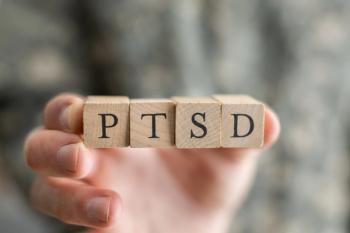
- Vol 35, Issue 9
- Volume 35
- Issue 9
Psychosocial Treatments for Trauma-Based Nightmares
Two evidence-based psychosocial treatments are available for trauma-based nightmares. The authors provide a case illustration for each method.
Either idiopathic or trauma-based, nightmares have an adverse effect on sleep continuity and efficiency. However, trauma-based nightmares are more frequent, are more intense, and they can persist throughout the lifespan. As might be expected, patients with PTSD have the highest incidence of trauma-based nightmares. Although nightmares are included in the DSM-5 diagnostic criteria for PTSD, they often persist even after first-line PTSD treatments have been successfully concluded.1
Two evidence-based psychosocial treatments are available for trauma-based nightmares: imagery rehearsal therapy (IRT)2 and exposure, relaxation, and rescripting therapy (ERRT).3 Both modalities utilize a brief, sequential approach that incorporates psychoeducation about trauma nightmares, sleep hygiene, relaxation, visual imagery, and “nightmare rescripting.” Even though IRT and ERRT share these basic aspects, they diverge when it comes to specific methods and their application.
To outline the application of each of these modalities, we provide a case illustration for each method. The cases were chosen based on the similarity of demographics and nightmare presentation in terms of frequency and intensity as well as previous trauma focused treatments.
Imagery rehearsal therapy
IRT is grounded in a “systematic desensitization” approach that creates a hierarchy of nightmares in which the patient moves from a moderately intense nightmare toward more distressing nightmares over the course of treatment. IRT focuses attention on changing the imagery system, which is hypothesized as an entrenched, habitual mental process that is dislodged through practicing alternative “rescripted,” neutral imagery.2,4
Subject information and brief history. Jack is a 66-year-old, married, white, Vietnam War veteran. He retired from an automotive factory job 4 years ago, where he frequently worked overtime or double shifts over the 34 years that he was employed there. He has been married for 35 years and has two adult children and three grandchildren. He describes his family relationships as emotionally distant but supportive.
He and his wife sleep in separate bedrooms because of his protracted nightmares and violent movements during sleep when having a combat-related nightmare. (Rapid eye movement behavior disorder has been ruled out prior to presentation). Jack reports that he has few friends and avoids social activities and public events. He used alcohol for several years to reduce stress and promote sleep. When alcohol abuse threatened his marriage and his job, he stopped drinking and began working overtime as often as he could in an attempt to exhaust himself, so he could sleep. This provided limited results as he got older; he was asked to take early retirement when his company began to lay off workers.
Presenting problems. Jack initially presented at the VA Healthcare System for medical problems related to high blood pressure and diabetes. He also reported that his sleep was poor and that he experienced multiple nightmares about the war every night. Jack was referred to the PTSD clinic for evaluation and treatment. On the Clinician Administered PTSD Scales (CAPS) he had a total score of 106 out of 120, evidencing severe PTSD. He met criteria for all three symptom clusters, ie, re-experiencing, avoidance, hyperarousal.
He reported that he was sleeping 2 to 3 hours each night and that he had vivid, recurrent nightmares each night when he did fall asleep. His nightmares and other PTSD symptoms had noticeably increased since his retirement, and as a consequence he was experiencing feelings of hopelessness and depression. His nightmares typically involve responding to several men screaming for a medic and working frantically to stop bleeding or close wounds only to have the soldier die.
Treatment intervention and course. Jack was engaged in prolonged exposure therapy to address his PTSD symptoms and he was prescribed citalopram and trazodone to address symptoms of PTSD, depression, and insomnia. He was able to complete 16 sessions of trauma-focused psychotherapy and reported a moderate reduction in PTSD symptoms (CAPS = 84), primarily regarding avoidance behaviors. He adhered to his medication regimen, which afforded 2 to 3 more hours of sleep some nights. However, he continued to report frequent nightmares.
He was referred to a group application of IRT in which 5 Vietnam war combat veterans were seen weekly for a period of 6 weeks to address trauma-related nightmares. He attended each of the group sessions. He was engaged and complied with treatment, and he was provided with a description of his nightmare as a habitual and self-perpetuating pattern of behavior that could be effectively addressed by treatment. IRT was introduced as well as breathing techniques, sleep hygiene principles, and mental imagery exercises.
Jack was asked to complete a list of his nightmares from the most distressing to the least, and from this hierarchy he chose a nightmare that was in the middle range of intensity using a subjective unit of distress (SUD) rating, from 0 to 100. He then wrote out the nightmare in detail and provided a SUD rating upon completion. He was asked to rescript this nightmare with another imaginal dream sequence of his choosing, which he wrote out in detail, and gave a SUD rating. His homework for the week was to rehearse the rescripted dream and practice sleep hygiene principles.
Each week progress was checked by reviewing his sleep diary, which provided data on sleep hygiene (ie, stimulus control, sleep environment), sleep latency, frequency of nighttime awakenings, wake time as well as nightmare frequency and intensity. When SUD for the target nightmare was reduced (SUD = 50/100), a more intense nightmare in the hierarchy was rescripted and practiced.
Exposure, relaxation, and rescripting therapy
ERRT is a cognitive behavioral, exposure-based approach to nightmare reduction, targeting the most intense nightmare as the focus of treatment. Treatment assists the patient identify core themes contained in the nightmare, such as safety, trust, power/control, intimacy, self-esteem. The nightmare content is rescripted in order to modifying the content based on the theme of the nightmare. As it is with IRT, the practice of rescripted nightmare content is followed by relaxation exercises, such as progressive muscle relaxation.3
Subject information and brief history. Charles is a 68-year-old, white, Vietnam war veteran, in his second marriage of 23 years, with an adult daughter from his previous marriage. He has been self-employed as a plumbing subcontractor for several years. He had had a number of skilled labor jobs but decided that he was better off working for himself. Charles has received treatment through the VA Healthcare System ever since his return from Vietnam in 1968 where he was severely wounded when his squad of 19 Marines walked into an ambush and only 6 survived.
Presenting problem. Charles was referred for nightmare treatment by his primary care physician after he completed 12 sessions of cognitive processing therapy for PTSD. He was able to complete first-line group psychotherapy and reported a moderate reduction in his PTSD symptoms, evidenced by a reduction in his CAPS total score of 18 points. However, he continued to struggle with repetitive nightmares of the ambush he had survived in Vietnam. His sleep was interrupted on a nightly basis and when he attempted to return to sleep the nightmare would continue where it left off. He typically experienced 3 to 4 hours of sleep per night and would stay up late to avoid the nightmare. Charles was having difficulty working because of fatigue, he was often irritable, and his family relationships were strained.
Treatment intervention and course. He started in an ERRT group with 4 other combat veterans who were seen weekly for 6 weeks to address trauma related nightmares. Initial sessions provided psychoeducation on trauma-related nightmares, sleep hygiene, and relaxation methods, which were practiced daily before sleep. He was asked to provide a detailed description of the most frequent and most intense nightmare and SUD rating before and after writing the description. He was also asked to identify the predominant theme of the nightmare (ie, safety, trust, power/control, intimacy, self-esteem), for which he identified safety and control as central themes in his nightmare. While maintaining the basic content of the nightmare, Charles worked with the therapist to construct new elements to the nightmare that addressed safety and control. Again, a SUD rating was established for the rescripted dream. These elements were included in a rescripted dream that Charles practiced every night 1 hour prior to a set bedtime, followed by progressive muscle relaxation.
Clinical outcomes
Imagery rehearsal therapy. Jack was able to complete the 6 sessions of IRT, and was adherent with between-session practice and rescription assignments. He was unable to reduce his SUD from his target nightmare to move to a higher-level nightmare, which impeded his progress in the therapy. He chose to rescript his nightmare with a mental image of fishing on a lake rather than content that reflected the subject matter of the nightmare, which appeared to reflect his avoidance of traumatic content. He stated that he could not change what happened in Vietnam and he believed he had nightmares “so that those soldiers would not be forgotten.”
He improved his sleep hygiene by reducing caffeine intake at night and establishing a regular bedtime and optimal bedroom environment. His pretreatment and post-treatment scores are seen in Figure 1.
Jack was referred for depression treatment and medication review as he continued to complain of low mood and insomnia. Jack continued to report frequent nightmares at the end of treatment. He was also referred to the Sleep Medicine Clinic at the VA for a full sleep study to provide a differential diagnosis and medication review.
Exposure, relaxation, and rescripting therapy. Charles completed each of the 6 sessions of ERRT and was adherent to the between-session practice. After his initial rescripting of the entire nightmare, he decided that there was one part of the nightmare that was the most difficult, and he focused on this with a more circumscribed theme identification and rescription. He showed improvement on each of the pretreatment measures (Figure 2).
The most significant outcome for Charles was the change in his attitude toward his sleep and dreaming. This was evidenced in his reduce anxiety, agitation, and fear about having a nightmare about the ambush and his increased sense of efficacy when these nightmares occurred. He reported that he was better able to stay asleep longer while dreaming and that he dreamt about smaller portions of the ambush. He also reported that he found he could return to sleep without the dream repeating.
Summary
The challenge in applying each of these approaches to nightmare treatment is that the clinician needs to be reasonably knowledgeable about sleep science, sleep disorders, relaxation methods, and trauma treatment. The presence of violent movements during sleep may also reflect other sleep pathology that warrants assessment by a polysomnogram. In such cases, collaboration with sleep disorders specialists may be of benefit. Overall, these nightmare treatments are brief and each session requires sufficient structure and preparation in order to get the maximum therapeutic benefit. This also applies to the between-treatment work as patients are encouraged to contact the therapist during the week if they are having difficulty with practicing the methods.
The IRT method presents particular challenges in that it is more difficulty to address avoidance behaviors, which are a hallmark of PTSD. Patients who utilize avoidance and/or safety behaviors in the rescripting process limit the therapeutic effect of the treatment. Moreover, it is difficult to move up a patient nightmare hierarchy in 6 to 8 sessions.4,5
ERRT adopts an exposure-based approach in identifying the most difficult nightmare first. This may present a challenge for therapists who are less familiar or uncomfortable with this method. Although the ERRT has a more structured protocol, therapists will require a significant degree of abstract thinking and cognitive flexibility assisting patients with rescripting their nightmares. It is important to note that trauma associated sleep disorder is a newly proposed parasomnia that develops after a traumatic experience and presents with nightmares, dream enactment behaviors, and other symptoms such as night sweats or tachycardia.
Disclosures:
Dr Favorite is Director, University of Michigan Psychological Clinic, Clinical Assistant Professor of Psychiatry, Michigan Medicine, and Clinical Psychologist at the Ann Arbor VA Healthcare System PTSD Clinical Team. Dr Conroy is Clinical Associate Professor of Psychiatry and Clinical Director of the Behavioral Sleep Medicine Program, Michigan Medicine, University of Michigan Hospital, Ann Arbor.
The authors report no conflicts of interest concerning the subject matter of this article.
References:
1. Swanson LM, Favorite TK, Horin E, Arnedt JT. A combined group treatment for nightmares and insomnia in combat veterans: a pilot study. J Traum Stress. 2009;22:639-642.
2. Krakow B, Zadra A. Clinical management of chronic nightmares: Imagery rehearsal therapy. Behav Sleep Med. 2006;4:45-70.
3. Davis JL. Treating Post-Trauma Nightmares: A Cognitive Behavioral Approach. New York: Springer; 2009.
4. Krakow B, Johnston L, Melendrez D, et al. An open-label trial of evidence-based cognitive behavior therapy for nightmares and insomnia in crime victims with PTSD. Am J Psychiatry. 2001;158:2043-2047.
5. Krakow B, Artar A, Warner TD, et al. Sleep disorder, depression, and suicidality in female sexual assault survivors. Crisis. 2000;21:163-170.
6. Favorite TK. Treatment of nightmares; clinical response. Grossman L, Walfish S, Eds. Translating Research into Practice: A Desk Reference for Practicing Mental Health Professionals. New York: Psychpubs, Springer; 2013:238-243.
Articles in this issue
about 7 years ago
Introduction: The Evolution of ADHDabout 7 years ago
Do Diet and Nutrition Affect ADHD? Facts and Clinical Considerationsabout 7 years ago
Issues Pertaining to Misuse of ADHD Prescription Medicationsabout 7 years ago
The Quiz: Cognitive-Behavioral Therapy and Chronic Painabout 7 years ago
Is Kansas a Real Place?about 7 years ago
Questions and Answers for Clinicians Facing the Opioid Epidemicabout 7 years ago
Psychocardiology: Understanding the Heart-Brain Connection: Part 1about 7 years ago
The PerfectionistNewsletter
Receive trusted psychiatric news, expert analysis, and clinical insights — subscribe today to support your practice and your patients.














